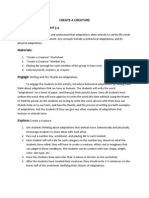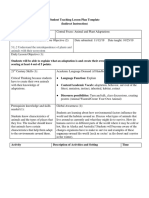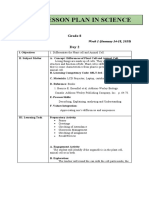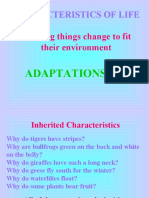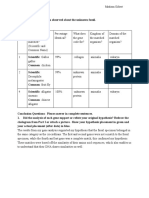Science Clinicals 5e Lesson Plan
Science Clinicals 5e Lesson Plan
Uploaded by
api-214216212Copyright:
Available Formats
Science Clinicals 5e Lesson Plan
Science Clinicals 5e Lesson Plan
Uploaded by
api-214216212Original Title
Copyright
Available Formats
Share this document
Did you find this document useful?
Is this content inappropriate?
Copyright:
Available Formats
Science Clinicals 5e Lesson Plan
Science Clinicals 5e Lesson Plan
Uploaded by
api-214216212Copyright:
Available Formats
Suzanne Earley ELED 3221---001 April 8, 2013 INDIRECT INSTRUCTION (STRUCTURED DISCOVERY) LESSON PLAN FORMAT Animal Instincts
Elementary Science _____________________________________________________________________________ Big Idea: Animal instincts and learned behavior, also the connection between animals and the environment they live in to survive. Grade Level: 4th grade Rationale: Students will learn the difference between animal instincts and learned behavior. They will examine the way animals behave, compared to other animals (including humans) and the environment in which they live in. NC Essential Standard(s): 4.L.1 - Understand the effects of environmental changes, adaptations and behaviors that enable animals (including humans) to survive in changing habitats.
National Science Education Content Standards Reference: K-4Content Standard A: Science as inquiry (Abilities necessary to do inquiry and understandings about scientific K-4Life Science Standards: Characteristics of Organisms; Organisms and environment
Instructional Objective: Students will learn about animal instincts. Students will know the difference between learned behavior and instincts and how animals used their instincts and learned behavior to survive/live compared to other animals. Students will see how animals adapt to the environment around them. Students will be able to relate their human instincts and behaviors to animal instincts and behaviors by viewing the video from Discovery Education. After viewing the video, students will be able to break off into groups and pick an animal and tell about the animal and its behaviors. You know students have met the objective if student are active within their group projects. They created a clear image of their animal, identified the animals diet, habitat and behavior; then creating a story for their animal including detail about their animals behavior. Prerequisite knowledge and skills: Students should know that the four main types of animals are mammals, reptiles, amphibians, and birds.
Materials/Resources: Animal Instincts video on discoveryeducation.com Concepts in Nature: Instincts in Animals Paper for writing and drawing about animal Reference material for reasearching animals Source of your lesson: http://www.discoveryeducation.com/teachers/free-lesson-plans/animal-instincts.cfm Estimated Time: 45 minutes 1 hour Accommodation for Special Needs/different learning styles: ESL: Visuals for students, along with print to go with visuals, to ensure student understands what is being taught. The video could be used as one visual. When presenting lesson, use basic language by recycling words and not adding a lot of new material; less is more. Give direct instructions on how to accomplish tasks, step by step. ADHD: Shorten up the first part of the lesson for ADHD students. Give less information. These students can also be the students who get to go to the board and write characteristics of the animal types.
Safety considerations: Students should be safe during this lesson, make sure that each student has a partner and no one gets left out.
Suzanne Earley ELED 3226--001 April 8, 2013 ______________________________________________________________________________ Content and Strategies (Procedure)
Engage: Start the lesson by telling your students that you want them to relax and imagine with you for a minute. Have your students to close their eyes, tell them to pretending they are climbing up a mountain. Here you add detail to your imagination like start climbing with you left foot, stretch out your arms to reach for the rock on the right, youre halfway there, etc. You could even have students to move their limbs as if they really were climbing up a mountain. You finally reach the top the mountain, and then you start to celebrate and shout WE MADE IT, WE MADE IT! At that moment you turn around and see that you found a cave. RAAWRRR! Did you hear that? one says, you turn around to see a bear. Now ask the students to open their eyes. Ask them what their instincts would when they saw that bear? Some kids might say run, some might say stand still and not make a sound. Then tell them that that those are both an instinct when you see a bear- to run or to be still. Today we are going to learn a little about animal instincts and animal learned behavior. Explore: An instinct is a fixed pattern of behavior, its innate meaning youre born to behave that way, and it comes natural. A learned behavior is behavior you learn by observed. An example of an instinct would be when babies start crawling or walking. It is just something they do. A learned behavior would be tying a shoe; you are taught how to tie your shoes. Now, we are going to watch a video on animals instincts. Play video, Concepts in Nature: Instincts in Animals on discoveryeducation.com. Explanation: After showing the video, ask "What is an instinct?" and "What is a learned behavior?" Students should reiterate the answer you gave them before you started the video, or what they learned from the video. Now, "Lets think back to the video, what animals were shown and can you think of an instinct of that animal?" This question was asked to know if they were really paying attention throughout the video. Other questions to ask about the video would be, "what is the difference between involuntary and reflexive?", "what is an involuntary action?", "what is a reflex action?", and "what/who do animals learn from?"
Elaborate: After discussing the video explain to the students that certain behaviors contribute to animals behavior. For example, bears can adapt to harsh winters by hibernating, and humpback whales migrate from their nurseries off the coast of Hawaii to feed in the krill-rich waters off of Alaska. Explain that some of these behaviors are instincts that animals are born with, and some are learned behaviors that are taught to the animal, often by a parent. For example, proboscis monkeys have an instinct for swimming (they never learn how to do it), but they must learn ways to cross a crocodile-infested river safely. Humans instinctively use their voices to communicate (newborn babies cry when they want something), but in order to speak, they must learn their language. Ask students to raise their hand if they could tell the different types of animals.
Student should all raise their hands to tell me the four types of animals which are mammals, reptiles, amphibians, and birds. Ask students to tell the characteristics of the animal types. This was all pre-requisite knowledge that they students had learned before. Mammals are warmblooded and have a backbone, Reptiles produces eggs and are cold blooded, Amphibian can live on the land and in water, and birds are the four types of animals we are going to use today. Students will but put into cooperative groups of three or so. Explain that they are going to work on a mini-project. The teacher will break students up into groups, assigning each group a type of animal. An average class size is around 24 students, so that will give you around 8 groups. Tell students which animal type they will be assigned, Mammal, Reptile, Amphibian, or Bird. Each group will pick an animal within their animal type and write a brief description about their animal, titled Diet, Habitat and Behavior and draw their animal. Students will be using reference material to research and write their brief description. Have each group member initial his or her written contribution to the description of their animal. Students can pick an animal in their category, the sky is the limit. Diet: describe the animals diet. What kind of food does your animal eat? Is your animal a meat eater (carnivore), a plant eater (herbivore), or does it eat both plants and animals (omnivore). Habitat: describe the animals habitat. Where does it live? What other animals or plants live there? Behaviors: Create individual list of all the behaviors you can find for your animal. Using group research, have each student compose a creative short story about his or her animals life during one of the four seasons of the year. Stories should reflect their group research, describing the animals environment, climate, diet, food, and physical attributes, and how they all affect animal behavior. Once the group presents their animal to the class, these stories and the group image can be displayed for the entire class. Challenge students to try to identify the learned and instinctual behaviors of the animals in their classmates stories. Evaluate: Students will be assessed based on a rubric to evaluate when students are working on their project and when they present their project as a group. 3-point Rubric3 points: Students actively participated in project, each giving ideas and information about animal to contribute to project. Created a clear image, created thorough, complete descriptions of their animals habitat, diet and behaviors. Developed creative stories with detail about animals behavior. 2 points: Students participated in group project, created an adequate image with minor descriptions about their animals habitat, diet and behaviors. Developed a story with some detail about animals behavior. 1 point: Student was not engaged in group project, created an incomplete image with an incomplete description of their animals habitat, diet and behavior. Developed a story with little to no detail about the animals behaviors. The students will turn in their projects for the teacher to review and hang on the way as an artwork. This will be a summative assessment. Closure: To close the lesson, ask students to explain why they picked the mammal, reptile, amphibian, or bird they did and tell about their behavior. Once all groups have gone, ask students what they learned about animal instincts today? Responses you should look for should be,
instincts are things you are born with, learned behaviors you pick up by watching (usually learned from parents), instincts help animals to survive, involuntary or reflexive, human instincts could involve walking, talking, crawling, etc. Different animals have different instincts. Instincts are different depending on the environment you live in and your surroundings. Once discussion about what the students learned is over, have students turn in their drawings for you to hang on the wall as artwork!
You might also like
- Grade 6 Science Revision NotesDocument29 pagesGrade 6 Science Revision Notesd4rky100% (16)
- Animal Diversity Eight EditionDocument512 pagesAnimal Diversity Eight EditionVikorn100% (1)
- Animal Adaptations Lesson PlanDocument4 pagesAnimal Adaptations Lesson Planuredtech100% (3)
- 4th Grade Animal Adaptations Final VersionDocument78 pages4th Grade Animal Adaptations Final VersionTGNo ratings yet
- SIOP Lesson PlanDocument16 pagesSIOP Lesson PlanKim GleasonNo ratings yet
- Living Non-Living Things Project.Document7 pagesLiving Non-Living Things Project.Rebeca Moya SevillaNo ratings yet
- Ubd AnimalsDocument4 pagesUbd AnimalsKathlene Joyce LacorteNo ratings yet
- Crayfish UnitDocument8 pagesCrayfish UnitgracieshoelacyNo ratings yet
- Peter Richelieu A Souls JourneyDocument87 pagesPeter Richelieu A Souls JourneytimthymailNo ratings yet
- Lesson 4Document3 pagesLesson 4api-709748758No ratings yet
- Create A CreatureDocument12 pagesCreate A Creatureapi-242068248No ratings yet
- Learning-Session-parra Del Riego Cyt 3Document5 pagesLearning-Session-parra Del Riego Cyt 3ScribdTranslationsNo ratings yet
- Lesson 1 - NeedsDocument5 pagesLesson 1 - Needsapi-254185642No ratings yet
- Melanie Cella Unit Plan 3 Grade Topic: Animals and EcosystemsDocument42 pagesMelanie Cella Unit Plan 3 Grade Topic: Animals and Ecosystemsapi-384066525No ratings yet
- Animal Movement Lesson PlanDocument14 pagesAnimal Movement Lesson Planapi-26744662867% (15)
- Science Lesson Plan 2Document5 pagesScience Lesson Plan 2api-400787901No ratings yet
- Lesson On AnimalsDocument3 pagesLesson On Animalsapi-313294376No ratings yet
- Animal AdaptationsDocument8 pagesAnimal AdaptationsAbigail AndresNo ratings yet
- Lesson 2Document5 pagesLesson 2api-432033189No ratings yet
- Weathering The WinterDocument5 pagesWeathering The Winterapi-239304942No ratings yet
- Long Form Lesson Plan TemplateDocument14 pagesLong Form Lesson Plan TemplateNandini RajNo ratings yet
- Major Animal Groups Lesson PlanDocument4 pagesMajor Animal Groups Lesson Planapi-740567085No ratings yet
- Inquiry Learning Planner: Understandings: Focus QuestionsDocument9 pagesInquiry Learning Planner: Understandings: Focus Questionsapi-286107656No ratings yet
- AnimalsDocument3 pagesAnimalsapi-255051895No ratings yet
- Science Lesson Plan Animal Survival Features - FinalDocument6 pagesScience Lesson Plan Animal Survival Features - Finalapi-321019642No ratings yet
- Student Teaching Lesson Plan Template (Indirect Instruction)Document6 pagesStudent Teaching Lesson Plan Template (Indirect Instruction)api-404657517No ratings yet
- Categories of Vertebrates: 1 Grade Science Unit PlanDocument7 pagesCategories of Vertebrates: 1 Grade Science Unit Planapi-205910346No ratings yet
- Science VivaDocument12 pagesScience Vivaapi-361857036No ratings yet
- Alaska Content Standard Alaska Standard C:: What Are Some Different Changes We Can See TodayDocument10 pagesAlaska Content Standard Alaska Standard C:: What Are Some Different Changes We Can See Todayapi-434818140No ratings yet
- Unit Lesson 1Document6 pagesUnit Lesson 1api-566153686No ratings yet
- 5e Lesson and ReflectionDocument6 pages5e Lesson and Reflectionapi-310650493100% (2)
- Lesson Plan 3 Characteristics of Viviparous AnimalsDocument5 pagesLesson Plan 3 Characteristics of Viviparous Animalsapi-509401871100% (1)
- Living Vs NonlivingDocument12 pagesLiving Vs NonlivingbrahmitrustNo ratings yet
- Project Wet Lesson PlanDocument4 pagesProject Wet Lesson Planapi-509778700No ratings yet
- 1.characteristics of Vertebrates Annd InvertebratesDocument16 pages1.characteristics of Vertebrates Annd InvertebratesJenny ViañaNo ratings yet
- ASSURE Model Instructional Plan: Lesson Title: Teacher's Name: Loden Malone Grade: Content Area: Lesson LengthDocument5 pagesASSURE Model Instructional Plan: Lesson Title: Teacher's Name: Loden Malone Grade: Content Area: Lesson LengthLodenMaloneNo ratings yet
- Lesson Plan: Abby Salm, Eric Trinh, Erica BarrDocument3 pagesLesson Plan: Abby Salm, Eric Trinh, Erica Barrapi-297038017100% (1)
- K1Our Amazing Animals and Plants 2013Document4 pagesK1Our Amazing Animals and Plants 2013DocumentosCarsonNo ratings yet
- Animal Adaptations Lesson PlanDocument5 pagesAnimal Adaptations Lesson Planapi-450175685No ratings yet
- Prezi LessonDocument3 pagesPrezi Lessonhitchings03No ratings yet
- Hoelzel Educ 230 Lesson Plan 1Document6 pagesHoelzel Educ 230 Lesson Plan 1api-549300278No ratings yet
- Putting Life in OrderDocument4 pagesPutting Life in OrderClaudia JaukinNo ratings yet
- Animal AdaptationsDocument12 pagesAnimal Adaptationsapi-290989321No ratings yet
- Completed Unit PlanDocument17 pagesCompleted Unit Planapi-377100307No ratings yet
- Casper Learning ExperiencesDocument21 pagesCasper Learning Experiencesapi-546467879No ratings yet
- Edt 317 Final Lesson Plan ReflectionDocument5 pagesEdt 317 Final Lesson Plan Reflectionapi-662885806No ratings yet
- Project Plan - 2013-14Document10 pagesProject Plan - 2013-14api-252683864No ratings yet
- Science Observation 1022Document3 pagesScience Observation 1022api-269470116No ratings yet
- Lesson2: Where Do Animals Live: Misconceptions For LearnersDocument5 pagesLesson2: Where Do Animals Live: Misconceptions For LearnersHessa Mohammed100% (1)
- Enrichment Lesson Plan: Animals and GroupsDocument4 pagesEnrichment Lesson Plan: Animals and Groupsapi-384273566No ratings yet
- Geneva College Beaver Falls, PA Science Lesson PlanDocument3 pagesGeneva College Beaver Falls, PA Science Lesson Planapi-534211248No ratings yet
- Lesson Plan Template: Ltexeira@hawaii - EduDocument5 pagesLesson Plan Template: Ltexeira@hawaii - Eduapi-282613412No ratings yet
- K-Science Perf ExpectationDocument7 pagesK-Science Perf Expectationapi-337098537No ratings yet
- STORYLINE Roland MonzónDocument16 pagesSTORYLINE Roland MonzónmonzonrolandNo ratings yet
- PortfolioDocument9 pagesPortfolioapi-510734030No ratings yet
- Microteach Lesson PlanDocument1 pageMicroteach Lesson Planapi-251385915No ratings yet
- XXX Preprimary Final Lesson PlansDocument22 pagesXXX Preprimary Final Lesson Plansapi-341114997No ratings yet
- Mammals Lesson Plan-1Document6 pagesMammals Lesson Plan-1api-309894157No ratings yet
- Science Lesson Plan 2 Bird Beak AdaptationsDocument4 pagesScience Lesson Plan 2 Bird Beak Adaptationsapi-302133453No ratings yet
- Animal Adaptations HomeworkDocument4 pagesAnimal Adaptations Homeworkafefiyxce100% (1)
- Living and Non-Living LessonDocument6 pagesLiving and Non-Living LessonTanzeela ShaikhNo ratings yet
- Jess Trider Nocturnal-2Document5 pagesJess Trider Nocturnal-2Anonymous xGBuNANo ratings yet
- Final ObservationDocument4 pagesFinal Observationapi-507999615No ratings yet
- Scan Doc0032Document1 pageScan Doc0032api-214216212No ratings yet
- Scan Doc0034Document1 pageScan Doc0034api-214216212No ratings yet
- Scan Doc0032Document1 pageScan Doc0032api-214216212No ratings yet
- Scan Doc0033Document1 pageScan Doc0033api-214216212No ratings yet
- Scan Doc0030Document1 pageScan Doc0030api-214216212No ratings yet
- Scan Doc0031Document1 pageScan Doc0031api-214216212No ratings yet
- Read The Passage Answer The Questions. Then Look at The Pictures and Give 3 Inferences You Made About What Is Happening Within The PictureDocument1 pageRead The Passage Answer The Questions. Then Look at The Pictures and Give 3 Inferences You Made About What Is Happening Within The Pictureapi-214216212No ratings yet
- Scan Doc0025Document1 pageScan Doc0025api-214216212No ratings yet
- Scan Doc0027Document1 pageScan Doc0027api-214216212No ratings yet
- Scan Doc0024Document1 pageScan Doc0024api-214216212No ratings yet
- Scan Doc0026Document1 pageScan Doc0026api-214216212No ratings yet
- Scan Doc0023Document1 pageScan Doc0023api-214216212No ratings yet
- Detailed Lesson Plan in Science 8 Animal Kingdom 2Document19 pagesDetailed Lesson Plan in Science 8 Animal Kingdom 2Rizalie JaleNo ratings yet
- 2.lesson Plan in Plant and Animal DifferDocument3 pages2.lesson Plan in Plant and Animal DifferClemente Castañeda MontillaNo ratings yet
- What Are AdaptationsDocument29 pagesWhat Are Adaptationsshahzeb khanNo ratings yet
- Have No Fear of ZoologyDocument202 pagesHave No Fear of ZoologyFaradilla Aqidatul Izzah50% (2)
- Animal KingdomDocument50 pagesAnimal Kingdomvaibhav100% (2)
- Blast LabDocument2 pagesBlast Labapi-408976248No ratings yet
- 6.animal Classification Class 10Document7 pages6.animal Classification Class 10Juned Mulani100% (4)
- Food ChainDocument16 pagesFood Chainirene9tan9ailianNo ratings yet
- Local Media1894370815660474219Document10 pagesLocal Media1894370815660474219galange267No ratings yet
- Jupeb 2019 Biology SyllabusDocument20 pagesJupeb 2019 Biology SyllabusAlexis RockelleNo ratings yet
- Name: - Score: - Directions: Read The Sentence Carefully. Encircle The Letter of The Correct AnswersDocument2 pagesName: - Score: - Directions: Read The Sentence Carefully. Encircle The Letter of The Correct AnswersblastasteroidNo ratings yet
- Study Island Life Science Assignment 1 Classification CellsDocument13 pagesStudy Island Life Science Assignment 1 Classification Cellsapi-243882603No ratings yet
- Explicit Lesson Plan For Science 6Document5 pagesExplicit Lesson Plan For Science 6Marry Joy Magallon100% (1)
- Mcat Self PrepDocument27 pagesMcat Self PrepAbdul Manan100% (1)
- PP2 EVS Syllabus - 2023-24Document8 pagesPP2 EVS Syllabus - 2023-24yourfrustratedemployeeNo ratings yet
- UNIT 2 Natural Science 2ºDocument35 pagesUNIT 2 Natural Science 2ºmaria arellanoNo ratings yet
- Phylum PoriferaDocument18 pagesPhylum Poriferagonoles81No ratings yet
- Evolution British English StudentDocument3 pagesEvolution British English Studentmateusz barskiNo ratings yet
- The Animal Kingdom - Rachel BladonDocument27 pagesThe Animal Kingdom - Rachel BladonAung Myo Kyaw100% (1)
- Science Daily Test 1Document6 pagesScience Daily Test 1Fayyad NabhaniNo ratings yet
- Greek and Latin Roots HandoutDocument4 pagesGreek and Latin Roots HandoutSiam SarkerNo ratings yet
- Lesson PlanDocument8 pagesLesson PlanHeizyl ann Velasco100% (1)
- Bio102syll Fall18Document11 pagesBio102syll Fall1827v29r2kq4No ratings yet
- The Classification of Living ThingsDocument5 pagesThe Classification of Living Thingsangelsolis15No ratings yet
- 4 Science Habitats Communities Food Chains AnswersDocument2 pages4 Science Habitats Communities Food Chains AnswersFahadNo ratings yet
- Science 8 Reviewer 4th QuarterDocument6 pagesScience 8 Reviewer 4th QuarterbaoingarjayNo ratings yet










